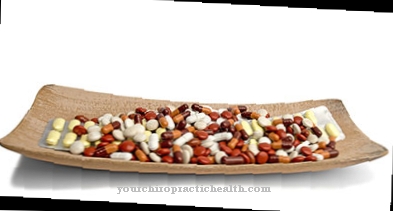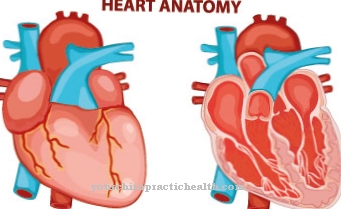As Type I tyrosinemia is a congenital metabolic disease. It occurs very rarely.
What is Type I Tyrosinemia?
The Type I tyrosinemia belongs to the group of tyrosinemia. It also bears the names Type I hypertyrosinemia or hepato-renal tyrosinemia. The rare congenital metabolic disease affects one in 100,000 newborn children. They are inherited in an autosomal recessive manner. Due to a defect in an enzyme, harmful metabolic products are formed during the breakdown of the amino acid tyrosine. The kidneys and liver are primarily affected in this disease. The occurrence of type I tyrosinemia can already be seen in babies or small children.
causes
Tyrosinemia type I is caused by a mutation on chromosome 15. This mutation causes a deficiency in the enzyme fumarylacetoacetase (FAH or FAA). The FAH enzyme catalyzes the two end products fumaric acid and acetoacetic acid as part of the metabolism of tyrosine. Due to the mutation, however, succinylacetoacetate, succinylacetone and maleyl acetoacetate are formed, which cause damage to the cells in the kidneys, liver and brain.
Furthermore, the functionality of the enzyme 5-aminilevulinic acid dehydratase is impaired by the defective metabolite succinylacetone. This results in damage to the nerves and leads to attacks that are similar to porphyria. The FAH gene, which is affected by the disease, is composed of 35,000 base pairs. In addition, an mRNA of 1260 base pairs is encoded. The most common mutation that occurs in type I tyrosinemia is an exchange of the nucleoside guanine for the nucleoside adenosine, which causes the mRNA to splice incorrectly.
Symptoms, ailments & signs
In tyrosinemia type I, it is important to differentiate between an acute and a chronic form. If the earliest form shows up, it occurs 15 days to 3 months after the birth of the affected child, causing liver cell necrosis and liver failure. The sick babies suffer from jaundice, diarrhea, vomiting, edema, ascites, hypoglycaemia and bleeding in the gastrointestinal area. Blood poisoning (sepsis) is a dreaded complication.
The acute failure of the liver is the first manifestation of tyrosinemia type I in around 80 percent of all children with the disease. The chronic form leads to liver damage and cirrhosis over time. In addition, there is an increased risk of liver cell carcinoma. This disease usually shows up between the ages of 15 and 25 months.
The kidneys are also damaged by tyrosinemia type I. This is noticeable by failure of the renal tubules. Damage to the kidney corpuscles as well as the breakdown of kidney function are within the realm of possible. Renal tubular acidosis and enlarged kidneys can also occur.
Type I tyrosinemia also causes neurological damage. The affected children suffer from increased muscle tone, painful abnormal sensations, an increased heart rate and an intestinal obstruction. After a short recovery period, paralysis spreads to the whole body.
Diagnosis & course of disease
In Germany, the tyrosine level in the blood is determined as part of a screening of newborn babies. However, only 90 percent of all sick children can be identified with this method. In the remaining 10 percent, the amino acid level only increases later. In the USA, it is also possible to determine succinylacetone, 5-aminolevulinic acid and methionine.
As part of the prenatal diagnosis, the succinylacetone can be determined from the blood of the umbilical cord by performing an umbilical cord puncture. Another option is to determine the activity of the FAH enzyme within chorionic cells or amniocytes. Since type I tyrosinemia is a very rare disease, little can be said about the length of the disease. If treatment is given early, the prognosis is usually positive.
Complications
Tyrosinemia type I is a very serious disease which, in the worst case, can lead to the death of the child. In many cases, the children die a few weeks or months after birth. The further course depends very much on the exact severity of the disease.
Those affected suffer from acute liver failure and thus from jaundice or from severe diarrhea. Vomiting or severe bleeding in the stomach or intestines also occur as a result of type I tyrosinemia and have a very negative effect on the patient's quality of life. For this reason, most children also die from liver failure.
Furthermore, there is an increased pulse and various abnormal sensations. An intestinal obstruction can also occur as a result of type I tyrosinemia and, in the worst case, lead to the patient's death. The treatment of tyrosinemia type I is carried out with the help of drugs and surgical interventions.
No general prediction can be made about the further course of the disease. However, the life expectancy of those affected is significantly limited. The parents and relatives of the affected children also suffer from severe psychological stress and therefore also need psychological treatment.
When should you go to the doctor?
With type I tyrosinemia, the person affected depends on treatment by a doctor. This disease cannot heal itself, so treatment by a doctor is always necessary. Since tyrosinemia type I is a genetic disease, genetic counseling should be carried out if you want to have children so that the disease does not recur. Consult a doctor at the first signs and symptoms of the disease.
In the case of type I tyrosinemia, the doctor should be contacted if the patient suffers from diarrhea, vomiting and jaundice. Furthermore, bleeding in the stomach area can also contribute to the disease. Parasitic sensations or an increased heart rate can also indicate the disease. Type I tyrosinemia can be diagnosed by a pediatrician or a general practitioner. Further treatment depends on the exact severity of the symptoms. In many cases, this disease also reduces the life expectancy of those affected.
Therapy & Treatment
The drug NTBC (nitisinone) is used to treat type I tyrosinemia. The enzyme 4-hydroxyphenylpyruvate dioxigenase is blocked by the nitisinone. This takes on the task of catalyzing an early breakdown step within the tyrosine metabolism. In this way there are no longer any substrates available that form toxic metabolites. The drug has a positive effect on around 90 percent of all sick babies and toddlers.
There is even improvement in the acute liver failure stage. The success of the treatment can be checked by determining the amount of succinylacetone. However, drug therapy cannot prevent the development of liver cell carcinoma. In spite of therapy, liver cancer sometimes occurs. Another important part of the treatment is a special diet. Its aim is to largely prevent the formation of tyrosine in the body. For the diet, the child is given food that contains neither tyrosine nor phenylalanine.
It is also high in calories. Due to the high nutritional value, it is possible to counteract catabolic conditions. In addition, tyrosine can no longer be released in the body through an external supply. Following this special diet, the child receives normal foods that contain little tyrosine and phenylalanine. Meals are distributed regularly and in equal amounts throughout the day.
Another treatment option is a liver transplant. It is used when the NTBC has no effect on the patient, which is the case in around 10 percent of all children.
prevention
Since type I tyrosinemia is a hereditary inherited disease, there are no effective preventive measures.
Aftercare
In most cases, those affected with tyrosinemia type I have only a few and usually only very limited direct follow-up measures available. For this reason, they should consult a doctor at an early stage so that further complications or complaints from this disease can be prevented. Self-healing cannot occur, so a doctor should be contacted at the first signs or symptoms.
In some cases, type I tyrosinemia can lead to infections or inflammation of the urinary tract or kidneys, so that treatment with the help of antibiotics is necessary. However, the disease cannot always be completely cured, so the affected person may remain sterile even after an operation.
The further course depends heavily on the time of diagnosis, so that a general prediction is usually not possible. The life expectancy of the person affected is not reduced by this disease. In some cases it can be useful to get in contact with other people affected by the disease in order to exchange experiences and methods.
You can do that yourself
The therapy of tyrosinemia type I can be supported by dietary measures. An energy-rich diet that provides the body with all the important amino acids is recommended. Adjusting the diet prevents the metabolism from mobilizing the tyrosine from the muscle tissue, which means that the metabolism can be normalized relatively quickly.
The diet should otherwise be balanced and even. It is important to have a diet in which the metabolism does not go into a catabolic state. That is why as many small meals as possible should be eaten, preferably evenly distributed throughout the day. The consumption of milk, meat and egg products must be severely restricted. Another important self-help measure is taking the prescribed medication such as nitisinone according to the doctor's instructions.
After a liver transplant, medical instructions must be followed first and foremost. Daily weight control and the consumption of lots of vegetables, fish and poultry are recommended. Meat, milk and dairy products should contain as little fat as possible. Fruit and especially grapefruits must be avoided as far as possible after a liver transplant. In addition, there are general rules of conduct for the time after a liver transplant.



























